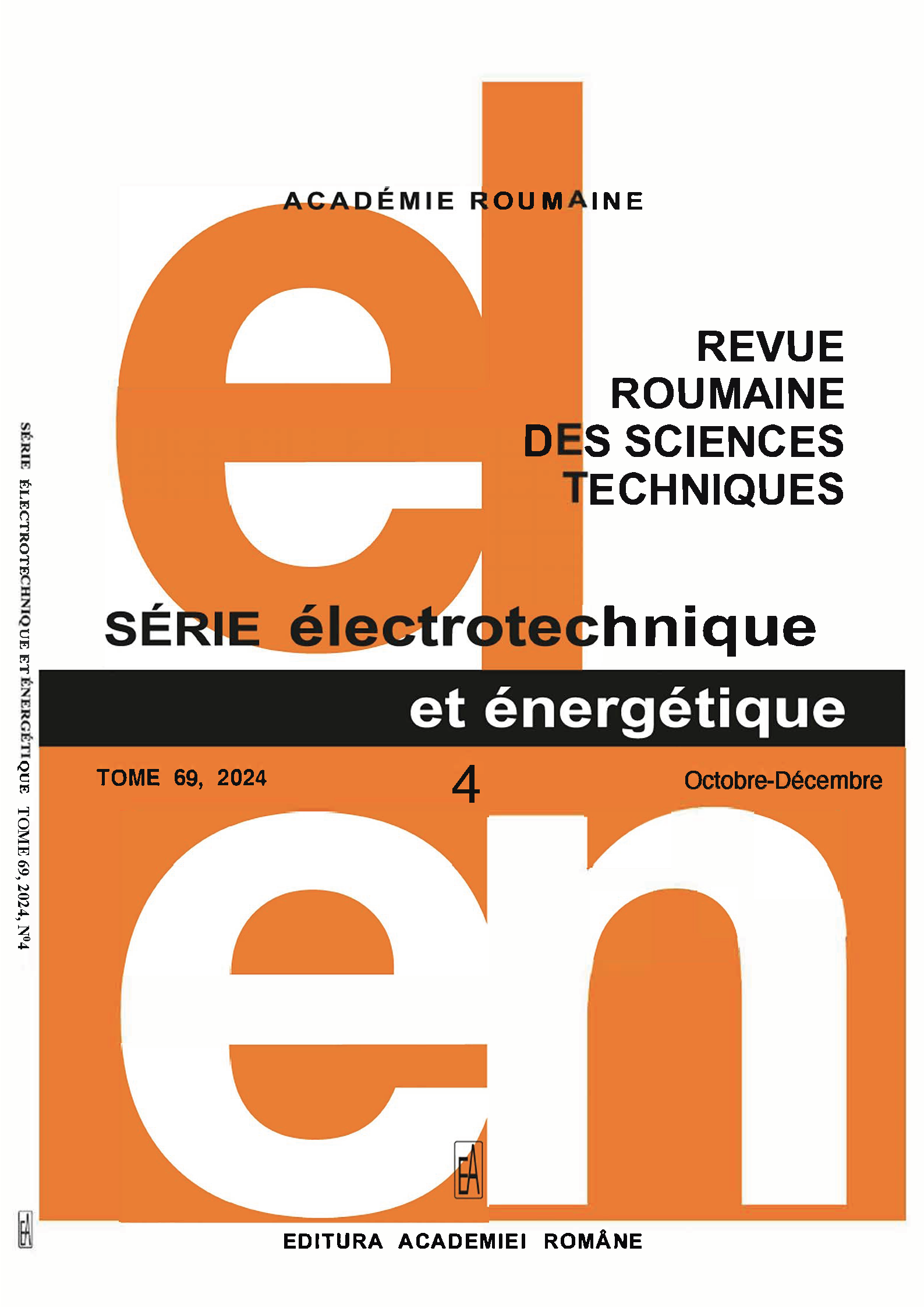MODULATION DE LARGEUR D'IMPULSIONS VECTORIELLES SPATIALES ALÉATOIRES CHAOTIQUE DESTINÉE AUX ENTRAÎNEMENT DE MOTEURS À INDUCTION DANS LES APPLICATIONS INDUSTRIELLES
SVPWM for Industrial Motor Drives
DOI :
https://doi.org/10.59277/RRST-EE.2024.69.4.6Mots-clés :
Entraînements à induction à distorsion harmonique totale, Génération d'impulsions aléatoires, Facteur de propagation harmonique, Modulation de largeur d'impulsion de vecteur spatial aléatoire chaotiqueRésumé
Dans cette ère industrielle, la commande des moteurs à induction joue un rôle essentiel, notamment dans le contrôle de la vitesse. L'ajustement de la vitesse est essentiel dans toutes les stratégies de contrôle du point de vue de l'application. Il existe différentes méthodologies de modulation de largeur d'impulsion pour régler la vitesse et réduire les harmoniques. Parmi les diverses stratégies de modulation de largeur d'impulsion (PWM), la PWM à vecteur spatial (SVPWM) s'avère la meilleure pour la réduction des harmoniques dans les applications d'entraînement à fréquence variable. La topologie SVPWM est modifiée en incorporant un certain caractère aléatoire, générant des impulsions de commutation pour l'onduleur, contrôlant ainsi les entraînements du moteur à induction. Un algorithme randomisé chaotique est synthétisé dans le SVPWM primitif et appelé SVPWM aléatoire chaotique (CRSVPWM). Il est prouvé à partir des résultats que l'efficacité et les performances sont plus élevées pour les entraînements à induction SVPWM randomisés chaotiques que pour toutes les méthodes conventionnelles de PWM, ayant des harmoniques plus élevées, un indice de modulation plus faible et moins de flexibilité. CRSVPWM présente les avantages d'une meilleure tension de sortie fondamentale, d'une réalisation numérique plus simple, de performances harmoniques améliorées et d'une extrême simplicité dans la sélection vectorielle. Il est simulé via MATLAB 2021R et une validation expérimentale basée sur le matériel a été effectuée à l'aide de l'environnement de la suite de conception Vivado avec Spartans-6 FPGA (XC6SLX9-2tqg144).
Références
(1) E.A.R. Engku Ariff, O. Dordevic, M. Jones, A space vector PWM technique for a three-level symmetrical six-phase drive, IEEE Trans. Ind. Electron., 64, 11, pp. 8396–8405, (2017).
(2) Y. Wang, H. Ge, H. Yin et al., Improved SVPWM modulation method for three-phase dual-input dual-buck inverters, J. Power Electron., 23, 736–745 (2023).
(3) H.G. Tahere Fadaeian, S. Asghar Gholamian, A novel discontinuous pulse width modulation strategy based on circuit-level decoupling concept for Vienna rectifier, Rev. Roum. Des Sci. Tech. Série Électrotechnique Énergétique. 65, 1–2, pp. 87–95 (2020).
(4) M.A. Hannan, J.A. Ali, A. Mohamed, M.N. Uddin, A random forest regression-based space vector PWM inverter controller for the induction motor drive, IEEE Trans. Ind. Electron., 64, 4, pp. 2689–2699, (2017).
(5) E. Benyoussef, E. Barkat, direct torque control based on space vector modulation with balancing strategy of dual star induction motor, Rev. Roum. Sci. Techn. – Électrotechn. Et Énerg., 67, 1, pp. 15–20 (2022).
(6) K. Lee, G. Shen, W. Yao, Z. Lu, Performance characterization of random pulse width modulation algorithms in industrial and commercial adjustable speed drives, Applied Power Electronics Conference and Exposition (APEC), IEEE (2016).
(7) S.K. Mondal, B.K. Bose, V. Oleschuk, J.O.P. Pinto, Space vector pulse width modulation of three-level inverter extending operation into overmodulation region, IEEE Trans. Power Electron., 18, 2, pp. 604–611, (2003).
(8) S. Lakhimsetty, N. Surulivel, Somasekhar, Improvised SVPWM strategies for an enhanced performance for a four-level open-end winding induction motor drive, IEEE Trans. Ind. Electron,. 64, 4, pp. 2750–2759, (2017).
(9) Y. Huang, Y. Xu, W. Zhang, J. Zou, Hybrid RPWM technique based on modified SVPWM to reduce the PWM acoustic noise, IEEE Trans. Power Electron., 34, 6, pp. 5667–5674, (2019).
(10) S. Nageswari, V. Suresh Kumar, Field programmable gate array implementation of variable common mode injection PWM for three-level inverters, Comput. Electr. Eng., 40, 4, pp. 1238–1252, (2014).
(11) L. Chengwu, Z. Xiaomin, J. Qiguang, Research on SVPWM inverter output control technology, Fifth International Conference on Measuring Technology and Mechatronics Automation, IEEE (2013).
(12) H. Chen, Y. He, J. Liu, X. Chen, H. Xiao, W. Zhi, R. Cheng, A novel hybrid SVPWM modulation algorithm for five level active neutral-point-clamped converter, Applied Power Electronics Conference and Exposition (APEC), IEEE (2019).
(13) G. Sun, G. Yang, J. Su, M. Wang, A hybrid random SVPWM method with full modulation ratio of five phase VSI, International Power Electronics and Application Conference and Exposition (PEAC), IEEE (2018).
(14) A. Janabi, B. Wang, Hybrid SVPWM scheme to minimize the common-mode voltage frequency and amplitude in voltage source inverter drives. IEEE Trans. Power Electron. 34, 2, pp. 1595–1610 (2019).
(15) S. Singh, S. Sonar, A new SVPWM technique to reduce the inductor current ripple of three-phase Z -source inverter, IEEE Trans. Ind. Electron. 67, 5, pp. 3540–3550, (2020).
(16) A. Boudouda, Power spectral density of dual randomized discontinuous pulse width modulation, Rev. Roum. Sci. Techn. – Électrotechn. Et Énerg.. 68, 2, pp.132–138, (2023).
(17) M. Paramasivan et al., An alternative level enhanced switching angle modulation schemes for Cascaded H Bridge multilevel inverters, IEEE Access, 11, pp. 57365-57382, 2023
(18) M.G. Neacşu, S.Ş. Matei, V.Ş. Stanciu, C.Nicolescu, I. Neacşu, Reaction wheel control based on field programmable gate array technolog Rev. Roum. Sci. Techn. – Électrotechn. Et Énerg.., 63, 4, pp.379-384, (2018).
Téléchargements
Publiée
Numéro
Rubrique
Licence
(c) Copyright REVUE ROUMAINE DES SCIENCES TECHNIQUES — SÉRIE ÉLECTROTECHNIQUE ET ÉNERGÉTIQUE 2024

Ce travail est disponible sous licence Creative Commons Attribution - Pas d'Utilisation Commerciale - Pas de Modification 4.0 International.


